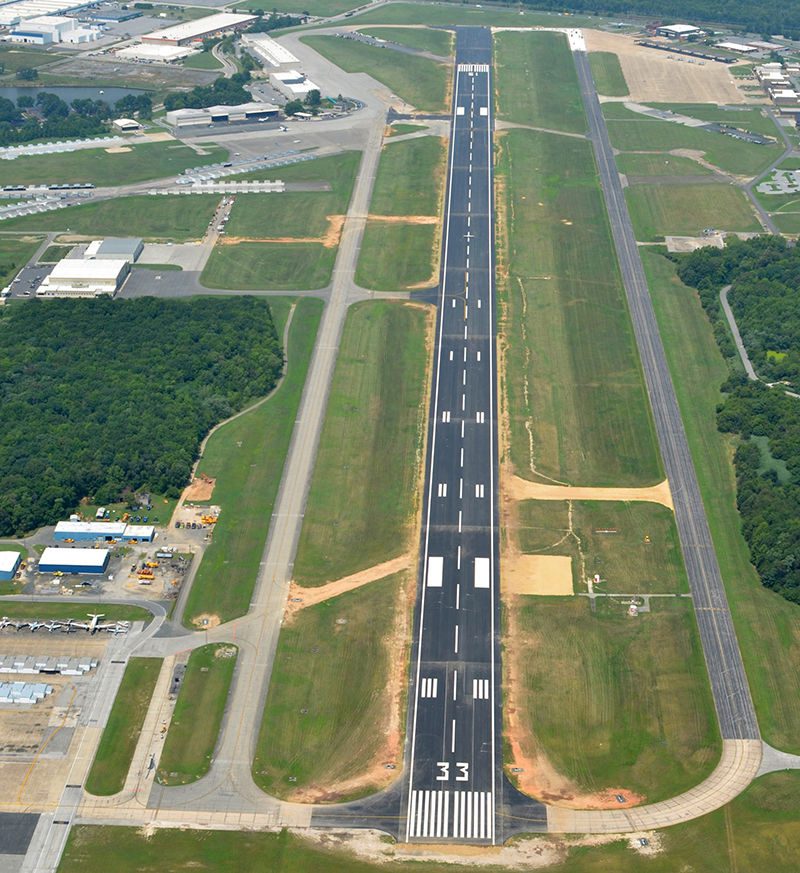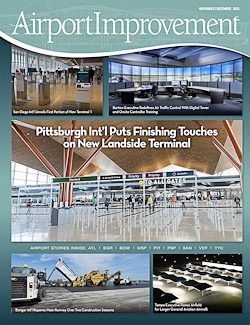When Martin State Airport (MTN) in Maryland finished reconstructing its sole runway last fall, the nearly $35.9 million project provided much more than fresh asphalt. The newly rebuilt runway, revamped taxiway system and desperately needed lighting improvements provide a smoother, safer airfield for MTN’s diverse general aviation and military traffic.
Runway 15–33 was originally built in 1940 and had received several modifications and overlays over the decades since. But by 2023, the surface had significant distress, uneven grades and frequent drainage issues. Taxiways also needed revamping, and the lighting system was prone to failure.
To tackle the airfield work, MTN opted for the traditional design-bid-build method and partnered with Michael Baker International and Airport Design Consultants Inc. for planning and design; Johnson, Mirmiran & Thompson for construction management and inspection; and P. Flanigan and Sons as the prime construction contractor.
| facts&figures
Project: Full-Length Runway Rehabilitation Location: Martin State Airport, in Middle River, MD Owner: Maryland Aviation Administration Associated Projects: Narrowing runway; removing 3 taxiways; reconstructing 2 taxiways; realigning 1 taxiway; new lighting & airfield signage Runway: 6,997 ft. Realigned Taxiway: 1,103 ft. Cost: $35.9 million Funding: Dept. of Defense & state grants Construction: Apr.–Oct. 2024, with 21-day closure in July Civil Design/Planning Lead & Construction Administration: Airport Design Consultants Inc. (ADCI) Owner’s Representative, Construction Management & Inspection: Johnson, Mirmiran & Thompson (JMT) Prime Engineering Design & Construction Administration: Michael Baker Int’l Prime Construction Contractor: P. Flanigan & Sons Project Review/Planning: FAA Electrical Construction: Glenelg Electrical Services: Brown-Tisdale Civil Engineering, Light/Signage Survey Layout: iCivl Inc. Partnering Facilitator: Crew Consulting Group Geotechnical Engineering: DMY Engineering Consultants Inc. Lighting: MRS Airfield Lights & Supply Trucking Services: Alfredo Trucking; Antonio’s Trucking; Gordon K. Jones Trucking; Henson Trucking, LLC; Powells Trucking Co. Inc.; SS Trucking; Wilshire Trucking Corp. Landscaping: Empire Landscaping LLC Survey Layout: KCI Hydro Excavation: EcoTech Hydro Excavation Concrete Pavement Construction: Machado Construction Co. Electrical & Stormwater Structure Construction: Priority Construction Asphalt Milling: Shaddai Milling LLC Concrete Breaking: Atlantic Breakers Airfield Pavement Sweeping: B&J Sweeping Quality Assurance Asphalt Plant Testing: Specialized Engineering Grooving: Cardinal Int’l Pavement Markings: Zone Striping Inc. Paving Fabric: Petromat MPG-100 Paving Fabric Installation: American Paving Fabrics Key Benefits: Enhanced safety; extended runway lifespan; improved infrastructure |
Communication and Strategic Scheduling
For MTN, completing the project was as much about keeping airport users safe and informed as it was about construction logistics. “We have over 200 tenants here, with many different operational needs and capabilities,” says Chief of Operations and Maintenance Harold Fowler. “So, the importance of communication and scheduling was not taken lightly.”
Owned and operated by the Maryland Aviation Administration, MTN is a reliever for Baltimore/Washington International (BWI) and joint civil-military airport. As a result, it has a wide variety of users, including the 175th Wing of the Maryland Air National Guard, major defense contractors including Lockheed Martin and Northrop Grumman, several flight schools, a variety of corporate operators and multiple helicopter units for law enforcement and medevac providers. The airport worked hard to make sure all were informed about the timeline and potential impacts of construction. “It goes a long way to ensure the preservation of safety,” Fowler notes.
Knowing the project would include heavy trucks coming and going, a guillotine-style concrete breaker demolishing old pavement, and significant construction noise during nightly runway closures, Fowler also prioritized communicating with the surrounding community. To keep local residents informed about project activities and updates, the airport added a landing page on its website. “It’s important that we maintain a good relationship with our neighbors,” Fowler emphasizes.
Remaining functional during construction required careful planning. Work began in April 2024 with normal airfield operations during the day and nightly closures for milling, paving, lighting installation and signage work. Helicopter operators such as Baltimore City and County Police, Maryland State Police and medevac companies continued their missions throughout the project, even during nightly runway closures.
In July 2024, the airport executed a 21-day full closure to complete the final two asphalt lifts and bring its new lighting system online. The Guard and other tenants were notified several months in advance so they could plan alternate flight activities while no runway was available at MTN. After the full shutdown period in July, night closures resumed through September for grooving and finishing work, with full completion in late October 2024.
“The work performed under this contract will ensure this major piece of infrastructure at MTN will serve tenants well into the future,” remarks Niqui Clark, deputy chief engineer with Maryland Aviation Administration.

Because MTN is a joint civil-military airport, it was able to combine state grants with funding from the U.S. Department of Defense. This allowed the airport to complete the entire project at once rather than phase it over several years, Fowler notes.
A Narrower, Safer Runway
The construction scope at MTN was extensive. The full 6,997-foot length of Runway 15–33 was milled, rebuilt with multiple lifts of asphalt, and grooved to improve traction. In some sections, up to six asphalt lifts were needed to rebuild the profile and cross slopes.
American Paving Fabrics Inc. installed PetroMat paving fabric over old concrete areas to reduce stress and mitigate reflective cracking. Tracy Hollida, project manager with Airport Design Consultants Inc., notes that project designers initially considered rubbilization or removing the existing asphalt to complete a crack-and-seat. Both strategies, however, were dismissed due to the high water table, environmental impacts, cost and/or operational impacts to the single-runway airport.
Although the previous published length of Runway 15–33 had been 6,995 feet, the pavement actually stretches to more than 8,100 feet from end to end. The updated runway design optimizes the current usable length and allows for future expansion and use. “The Maryland Aviation Administration also has a desire to maximize the published length of the runway to 8,000+ feet to align with the existing pavement,” comments Cedrick Johnson, project principal with Airport Design Consultants Inc. “Increasing usable runway length would provide better opportunities for Maryland Air National Guard missions.”

The width of the runway was decreased from 180 feet to 150. The original wider version was designed for past military needs, but the current FAA standard of 150 feet was deemed sufficient for current and future operations at MTN. “Varying widths were coordinated with the FAA, and all stakeholders settled on the 150-foot width with 15-foot paved shoulders,” explains Keith Fritz, senior engineer with Airport Design Consultants Inc. Shoulders were limited to 15 feet instead of the standard 20 feet to minimize environmental impacts near Chesapeake Bay. The 5 extra feet on each side was regraded into turf after existing lights were removed.
 Although the width change may sound minor, it has significant strategic implications. “Decreasing that width of the runway brings us into the FAA standards, which helps going into the future if we wanted to request FAA funds for any type of work on the runway,” Fowler explains.
Although the width change may sound minor, it has significant strategic implications. “Decreasing that width of the runway brings us into the FAA standards, which helps going into the future if we wanted to request FAA funds for any type of work on the runway,” Fowler explains.
For the Operations team, a narrower runway means less surface to plow during winter storms, which employees already benefited from last winter.
Beyond rebuilding and narrowing the runway, the project reconstructed taxiways A and C to current FAA standards and realigned Taxiway C to a perpendicular orientation, eliminating a confusing five-way configuration. Taxiways B, D and S were removed to improve safety and reduce pavement maintenance. “The removal of those taxiways made things safer and less confusing,” Fowler reports.
Lighting Upgrades
Another pressing issue was airfield lighting. Because of a notably high water table at MTN, the former electrical system for lighting was often underwater. “We would have outages very frequently,” Fowler recalls. “We were kind of just chasing it—trying to find where the issue was. It became unreliable, so that was becoming a safety issue.”

Repeated lighting failures were inconvenient for all tenants, but the outdated system also impeded night training for the Air National Guard because staff could not dim the runway lights to very low settings. “That was a key aspect of their preparation they weren’t able to do,” Fowler relates.
This and other shortcomings were fixed when the entire airfield lighting system was updated with new fixtures, new cabling, an upgraded vault and a modernized control system. All runway and taxiway edge lights were replaced with LED fixtures, new conduit and base cans were installed and a network of junction cans was added in the infield to make maintenance safer and easier.
Additionally, crews rebuilt the homerun cabling to the lighting vault, reconstructed the duct bank system and updated the airfield lighting control system with new hardware and software. Planning ahead, designers included homerun duct banks and a parallel communication duct bank sized to support future needs of the FAA Air Traffic Control Tower. New signage was added throughout the airfield to reflect the new taxiway layout.
Thanks to recent improvements, night training is now more realistic and rigorous for the Guard, and civilian pilots can depend on MTN’s airfield lighting, too. “Our lighting system was beginning to become an unreliable aspect of the runway, so having it completely replaced significantly upgraded our service capabilities and eliminated a maintenance headache,” Fowler remarks.
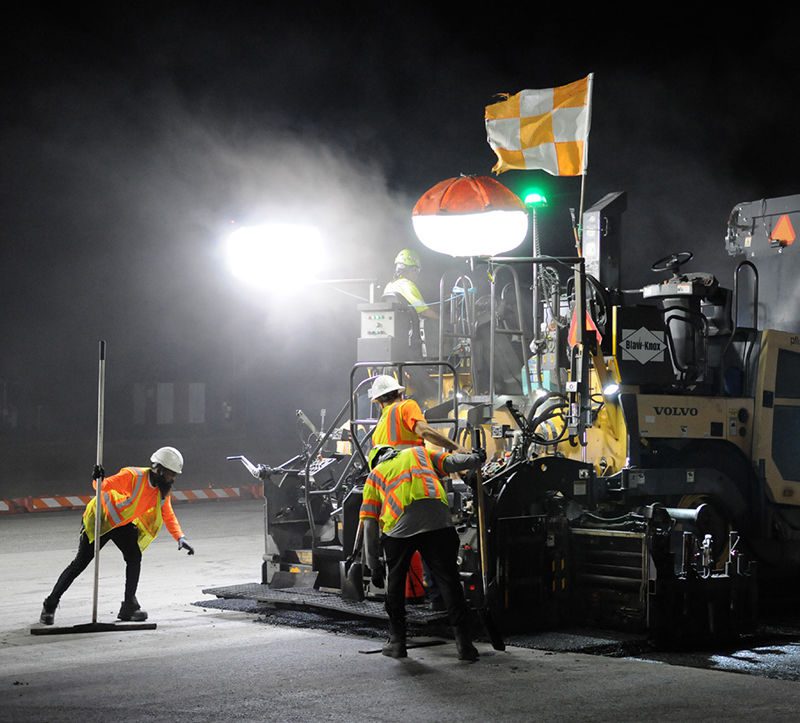
Overnight closures helped crews keep the project on schedule.
Innovative Measures
 Early in the project, the engineering design team leveraged robust geotechnical investigation, including dynamic cone penetrometer testing, pavement cores and 13 standard penetration test borings. “This informed decisions on pavement rehabilitation strategies, such as avoiding crack-and-seat methods in favor of geosynthetic fabric overlays,” explains Jeffrey Kolb, senior associate and technical manager of Aviation with Michael Baker International. The chosen approach balanced durability with the need to limit extended runway closures, he adds.
Early in the project, the engineering design team leveraged robust geotechnical investigation, including dynamic cone penetrometer testing, pavement cores and 13 standard penetration test borings. “This informed decisions on pavement rehabilitation strategies, such as avoiding crack-and-seat methods in favor of geosynthetic fabric overlays,” explains Jeffrey Kolb, senior associate and technical manager of Aviation with Michael Baker International. The chosen approach balanced durability with the need to limit extended runway closures, he adds.
Engineers also used mobile LiDAR to capture high-resolution survey data during one of the overnight runway closures. This allowed the design team to generate highly accurate base maps and align the rehabilitation plan precisely with existing conditions, Kolb explains. Using LiDAR accelerated design development and minimized the risk of conflicts during construction, especially in areas where geometry and grading adjustments were critical to meeting FAA and Unified Facilities Criteria standards.
Complex Scope and Circumstances
 Rehabilitating Runway 15–33 and other associated improvements presented a series of challenges from planning through construction. With cross-slopes measuring less than 1% in many areas, the runway had long suffered from inadequate drainage. To correct the issue, designers raised the centerline area to improve water runoff—an adjustment had to be planned carefully. “The raised profile of the runway also had to be balanced with the asphalt material cost to build the runway higher, so the project budget was not exceeded,” notes Tom Varughese, director of the Maryland Aviation Administration Office of Engineering and Construction. Because the asphalt sat on top of a structurally sound concrete base, additional strengthening was not needed; instead, the focus was on achieving proper grades. Adjusting the runway grades, in turn, required reworking the profiles of connector taxiways to match the new elevations.
Rehabilitating Runway 15–33 and other associated improvements presented a series of challenges from planning through construction. With cross-slopes measuring less than 1% in many areas, the runway had long suffered from inadequate drainage. To correct the issue, designers raised the centerline area to improve water runoff—an adjustment had to be planned carefully. “The raised profile of the runway also had to be balanced with the asphalt material cost to build the runway higher, so the project budget was not exceeded,” notes Tom Varughese, director of the Maryland Aviation Administration Office of Engineering and Construction. Because the asphalt sat on top of a structurally sound concrete base, additional strengthening was not needed; instead, the focus was on achieving proper grades. Adjusting the runway grades, in turn, required reworking the profiles of connector taxiways to match the new elevations.
Grading also directly affected the fit of new edge lighting and, ultimately, reopening the runway on time after the 21-day closure. The contractor, construction manager, design team and Aviation Administration worked together closely and continually reviewed survey data against the planned lift sequence. Adjustments were made in real time and relayed to field crews to keep paving work on schedule and finish with grades that matched design specification.
 Contractors got a jump on the overall project schedule by installing the duct bank early since it is outside active runway and taxiway areas. “Completing this work in advance of the spring start for night closures took some construction tasks off the to-do list,” recalls Mark Tiger, construction manager with Johnson, Mirmiran & Thompson. This allowed electrical and general crews to move more efficiently once the main rehabilitation began and provided valuable momentum for the lighting and signage upgrades.
Contractors got a jump on the overall project schedule by installing the duct bank early since it is outside active runway and taxiway areas. “Completing this work in advance of the spring start for night closures took some construction tasks off the to-do list,” recalls Mark Tiger, construction manager with Johnson, Mirmiran & Thompson. This allowed electrical and general crews to move more efficiently once the main rehabilitation began and provided valuable momentum for the lighting and signage upgrades.
Realigning and rehabilitating connector taxiways to meet the operational requirements of both civilian and military users was critical. “The rehabilitation ensured that both sides—Taxiway F (civilian) and Taxiway T (military)—were integrated into the design, supporting seamless operations across the airfield,” Kolb notes.
Narrowing the runway width from 180 feet to 150 created challenges for lighting installation. Typically, edge lights are placed into the pavement, but that would have complicated the process at MTN. “The existing runway concrete was extremely hard, so much so that it had previously damaged rock wheel equipment,” Kolb explains. “To avoid disconnected pavement strips and extensive rock wheeling (over 16,000 feet), transformer cans located in the turf and connected to edge light base cans were used instead, minimizing runway shutdown time.”
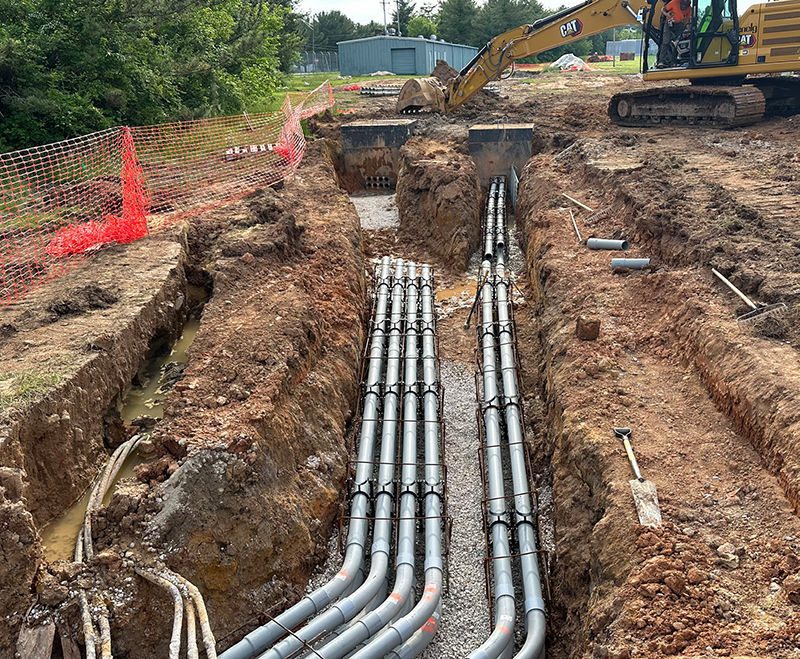
 Nevertheless, excavation to install the conduit and base cans was tricky due to large aggregate in some areas just below the concrete. “The electrical contractor sped up the operation by cutting the limits in advance, which required more time for the activity but kept pace for the mill-pave pattern,” recalls Paul Shank, chief engineer and chief of the Maryland Aviation Administration Division of Planning and Engineering.
Nevertheless, excavation to install the conduit and base cans was tricky due to large aggregate in some areas just below the concrete. “The electrical contractor sped up the operation by cutting the limits in advance, which required more time for the activity but kept pace for the mill-pave pattern,” recalls Paul Shank, chief engineer and chief of the Maryland Aviation Administration Division of Planning and Engineering.
Other complicating factors included long lead times for electrical components, unexpected survey discrepancies and heavy rain during the 21-day closure that required around-the-clock work to keep the project on schedule.
A tragic event outside the airport also added to the complexity. After Baltimore’s Francis Scott Key Bridge collapsed, asphalt trucks had to reroute through city tunnels, creating nightly logistical challenges sometimes compounded by sporting events and scheduled lane closures. Suddenly, managing material deliveries and the paving schedule was a whole new game.
Lessons Learned
 For Airport Design Consultants Inc, the project underscored the value of pairing thoughtful design with close stakeholder coordination. Key elements included the stress-relieving membranes for long-term protection against reflective cracking, and the extended 24/7 runway closure to help crews complete critical work safely and efficiently. “The decision to ‘rebuild in place’ rather than perform a full-depth reconstruction allowed the runway to remain open daily during most of the construction,” adds Hollida.
For Airport Design Consultants Inc, the project underscored the value of pairing thoughtful design with close stakeholder coordination. Key elements included the stress-relieving membranes for long-term protection against reflective cracking, and the extended 24/7 runway closure to help crews complete critical work safely and efficiently. “The decision to ‘rebuild in place’ rather than perform a full-depth reconstruction allowed the runway to remain open daily during most of the construction,” adds Hollida.
Kolb, from Michael Baker International, says other airports can learn from MTN’s emphasis on designing for both current and future conditions, conducting thorough geotechnical analysis before committing to a strategy and integrating electrical upgrades with long-term infrastructure plans. He also highlights the value of formal partnering sessions with all stakeholders to capture lessons learned, share concerns and improve coordination. For joint-use airports, he recommends early collaboration between civilian and military users to ensure airfield geometry and standards support both missions.
As the airport’s Chief of Operations and Maintenance, Fowler’s biggest takeaway was the importance of early and frequent communication with all project stakeholders and the community. “If everyone is aware of things that are happening, that works to eliminate some of the potential hazards,” he remarks. Effective communication goes a long way to protecting safety, operations and relationships, he adds.
Results of the airfield upgrades have been widely praised. Tenants say they appreciate the smoother, better-draining runway and improved lighting. “We’ve gotten great reviews from the pilots,” Fowler reports. “The removal of those non-standard taxiways has made operations safer and less confusing.”
What’s Next
Construction has begun on a new ADA-compliant air traffic control tower with more space and full airfield visibility for air traffic control tower staff. It will replace the airfield’s current tower, which was built in 1940 and is one of the oldest in the United States.
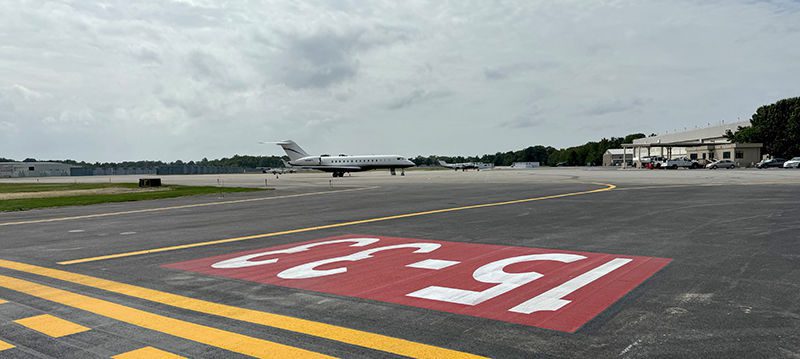
Project designers had to accommodate the operational needs of general aviation and military aircraft.
Looking further ahead, plans are underway to add charging infrastructure for electric aircraft and more corporate hangars. A major expansion of the Glenn L. Martin Aviation Museum, which is located at the airport, could turn the facility into one of Maryland’s premier aviation attractions.
With a renewed runway, modernized airfield lighting and additional improvement projects already underway, MTN is positioned to serve the general aviation community and support the nation’s defense missions well into the future.

